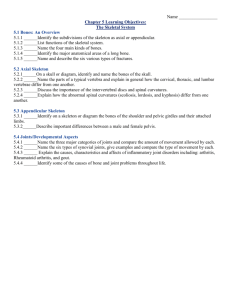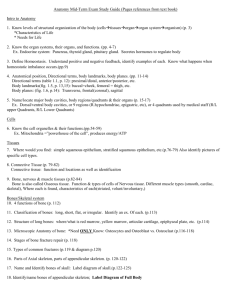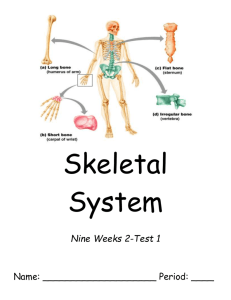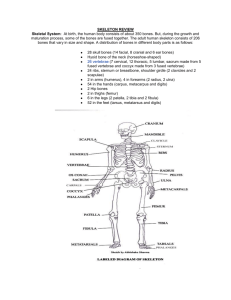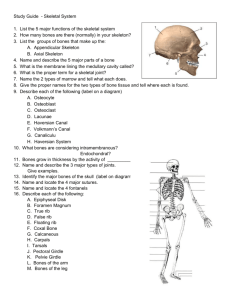1-Anatomical terms
advertisement
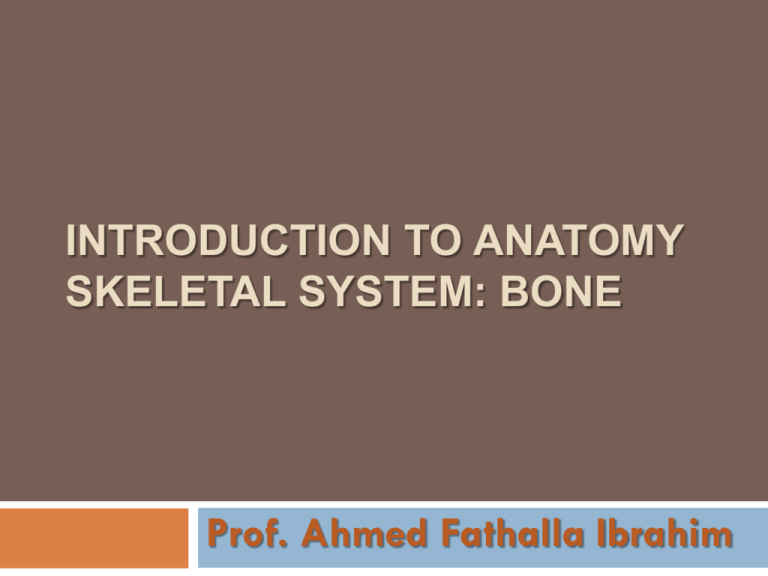
INTRODUCTION TO ANATOMY SKELETAL SYSTEM: BONE Prof. Ahmed Fathalla Ibrahim OBJECTIVES At the end of the lecture, students should be able to: Define the word “Anatomy” Enumerate the different anatomical fields Describe the anatomical position Describe different anatomical terms of position & movements as well different anatomical planes Classify bones according to shape, structure & development Enumerate different bones of both axial & appendicular skeleton ANATOMY The science which deals with the study of: the structure and shape of the body body parts & their relationships to one another ANATOMICAL SCIENCES Gross Anatomy: Study of human body with naked eye Microscopic Anatomy (Histology): Study of fine structure (cells & tissues) of the human body with the help of microscope Developmental Anatomy ( Embryology) Radiological Anatomy Cross-sectional Anatomy Applied Anatomy Surgical Anatomy ANATOMICAL POSITION It is the standard position in which the body assume to describe its parts. Body is erect Arms hanging by the side Palm facing forward Feet parallel ANATOMICAL TERMINOLOGY TERMS OF POSITION Superior (cranial): near to head Inferior (caudal): away from head Anterior (ventral): near to front Posterior (dorsal): near to back Medial: near to median plane Lateral: away from median plane Proximal: near to trunk Distal: away from trunk Superficial: near to skin (surface) Deep: away from skin ANATOMICAL TERMINOLOGY TERMS OF MOVEMENT Flexion: approximation of 2 parts (decreasing the angle between 2 parts) Extension: straightening (increasing the angle between 2 parts) Abduction: away from median plane Adduction: toward median plane Lateral rotation: rotation away from median plane Medial rotation: rotation toward median plane Circumduction: combined movements of flexion, extension, abduction & adduction ANATOMICAL PLANES & SECTIONS Sagittal (median): divides the body into 2 equal halves (right & left) Parasagittal (paramedian): divides the body into 2 unequal parts (right & left) Frontal (coronal): divides the body into anterior & posterior parts Transverse (cross): divides the body into superior & inferior parts PLANES, TERMS OF POSITION & TERMS OF MOVEMENT BODY CAVITIES 1. 2. 1. 2. Ventral body cavity: divided by diaphragm into: Thoracic cavity: superior to diaphragm, contains heart & lungs Abdominal cavity: inferior to diaphragm, contains stomach, intestine, liver, urinary bladder, etc… Dorsal body cavity: divided into 2 parts continuous with each other: Cranial cavity: space inside skull, contains brain Spinal cavity: space inside vertebral column, contains spinal cord SKELETAL SYSTEM Includes: Bones Joints: articulations between bones FUNCTIONS OF BONE 1. 2. 3. 4. 5. 6. Support: of the body organs Protection: of soft body organs Attachment :of muscles Movement: of the body as a whole, or of the body parts Storage: of fat and minerals e.g. calcium and phosphorus Blood cell formation CLASSIFICATION OF BONE Bones are classified on the bases of their: Shape: long, short, flat, irregular Structure: compact, spongy Development: membrane, cartilage THE SKELETON 1. 2. Formed of 206 bones Divided into: Axial skeleton: bones forming the trunk (longitudinal axis) of body Appendicular skeleton: bones forming the girdles & limbs BONES OF AXIAL SKELETON 1. 2. SKULL Consists of: Cranium: bones enclosing brain: frontal, occipital, parietal, temporal Facial bones: bones of face: maxilla, nasal, zygomatic, mandible BONES OF AXIAL SKELETON 1. 2. 3. 4. 5. VERTEBRAL COLUMN Number: 33 vertebrae Functions: protects spinal cord and supports the body Formed of: 7 cervical vertebrae 12 thoracic vertebrae 5 lumbar vertebrae 5 sacral vertebrae fused to form sacrum 4 coccygeal vertebrae fused to form coccyx BONES OF AXIAL SKELETON STERNUM Has 3 parts: manubrium, body & xiphoid process RIBS Number: 12 pairs All ribs articulate with vertebrae Only upper 7 pairs articulate with sternum BONES OF APPENDICULAR SKELETON PECTORAL GIRDLE Connects upper limb with axial skeleton Formed of: clavicle & scapula (2 bones on each side) PELVIC GIRDLE Connects lower limb with axial skeleton Formed of: hip bone (one bone on each side) BONES OF APPENDICULAR SKELETON 1. 2. 3. UPPER LIMB Bone of arm: humerus Bones of forearm: radius (lateral) & ulna (medial) Bones of hand: 8 carpal bones 5 metacarpal bones 14 phalanges: 2 for thumb & 3 for each of medial 4 fingers BONES OF APPENDICULAR SKELETON 1. 2. 3. LOWER LIMB Bone of thigh: femur Bones of leg: fibula (lateral) & tibia (medial) Patella Bones of foot: 7 tarsal bones 5 metatarsal bones 14 phalanges: 2 for big toe & 3 for each of lateral 4 toes LONG BONES Formed of: A shaft (diaphysis): composed of compact bone Two ends (epiphysis): composed of spongy bone The region of contact between epiphysis & diaphysis is called: metaphysis: contains epiphyseal plate of cartilage responsible for linear bone growth QUESTION 1 1. 2. 3. 4. Which one of the following bones is a bone of the axial skeleton? Femur Humerus Scapula Sternum QUESTION 2 1. 2. 3. 4. Which one of the following bones is an example of an irregular bone? Femur Vertebra Scapula Sternum QUESTION 3 1. 2. 3. 4. Which one of the following planes divides the body into superior & inferior parts? Frontal (coronal) plane Sagittal (median) plane Parasagittal (Paramedian) plane Transverse plane THANK YOU

